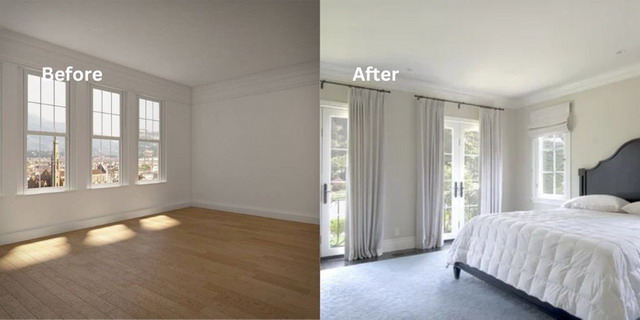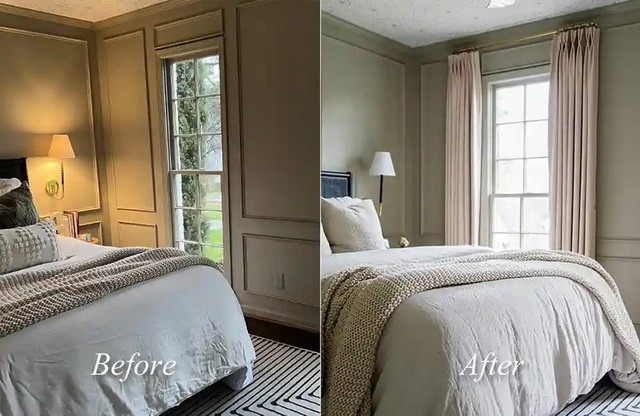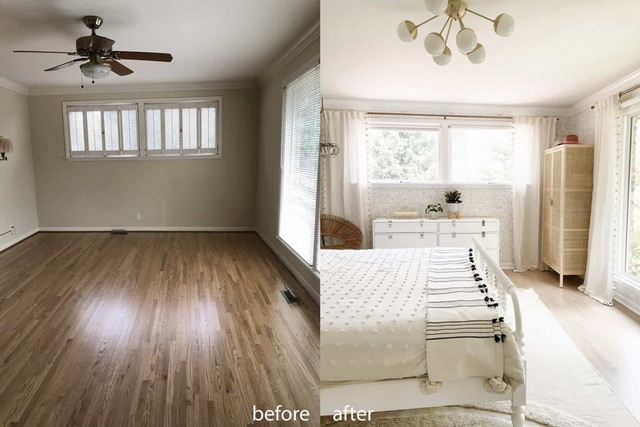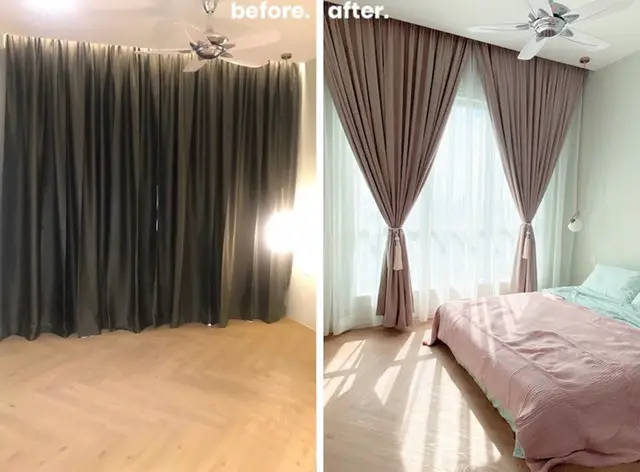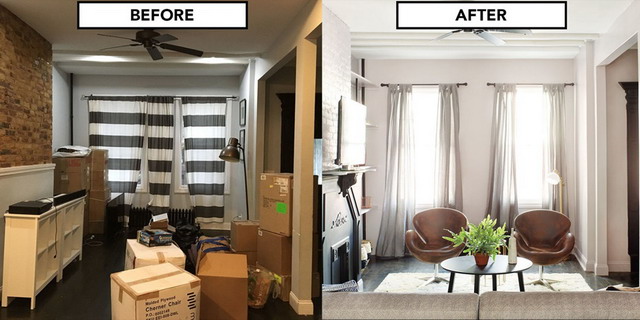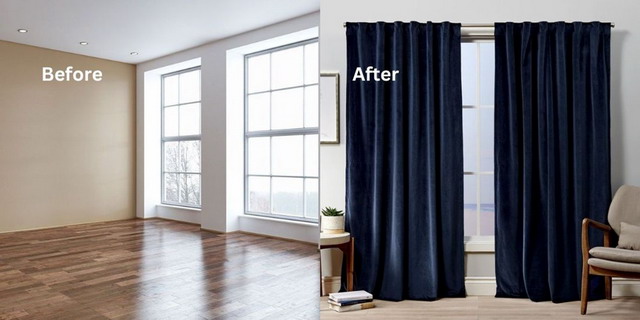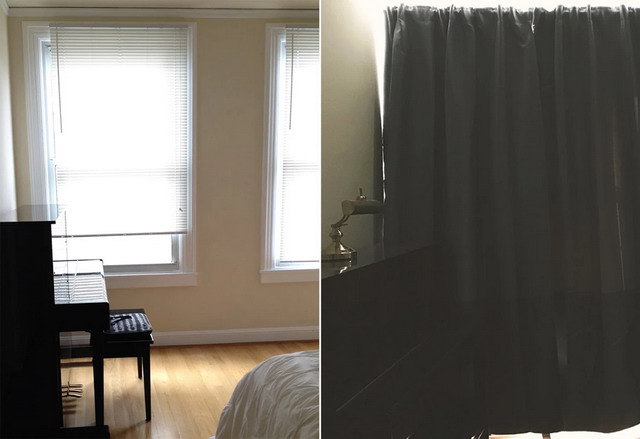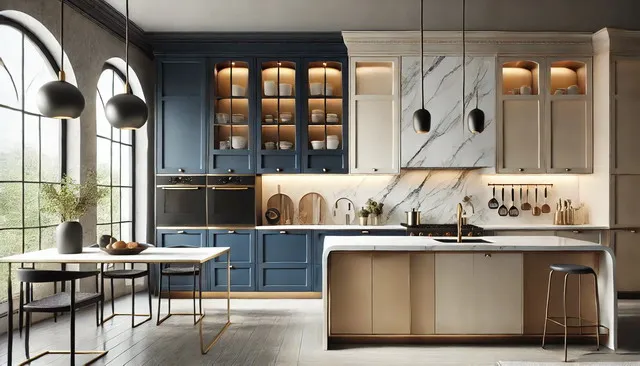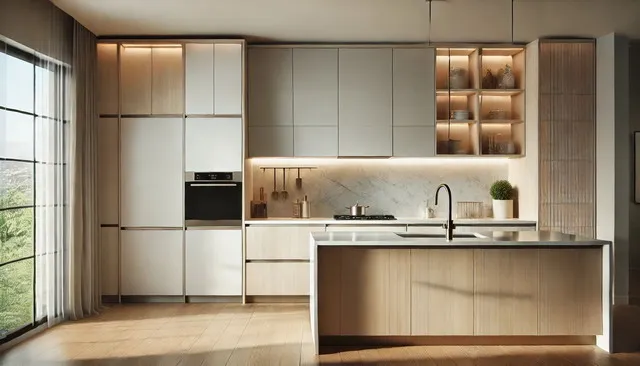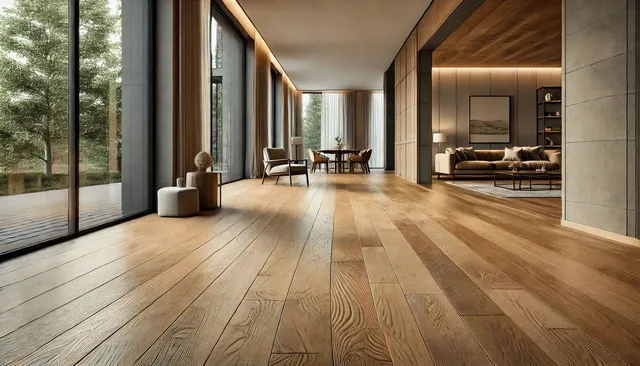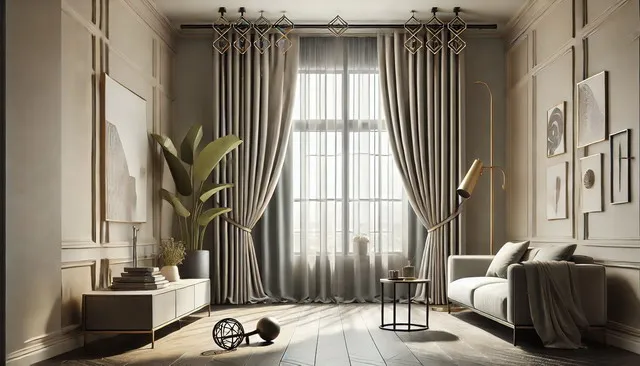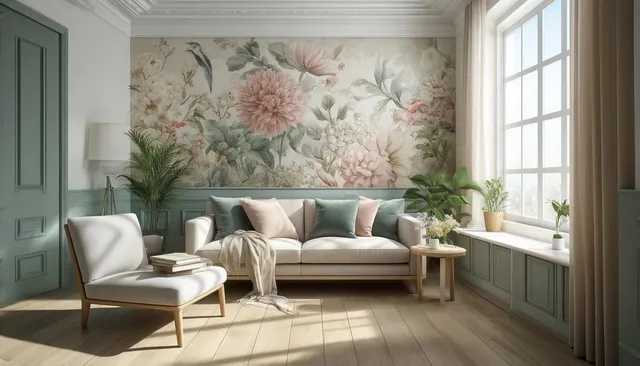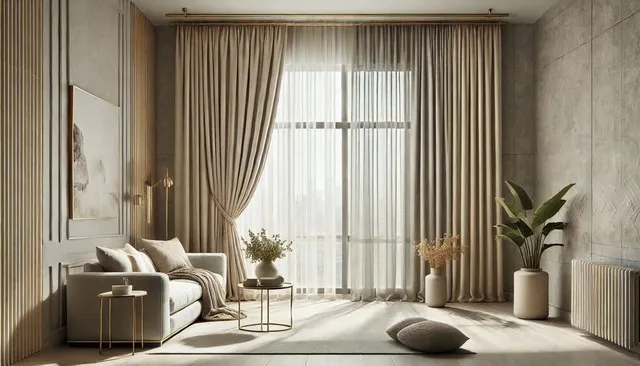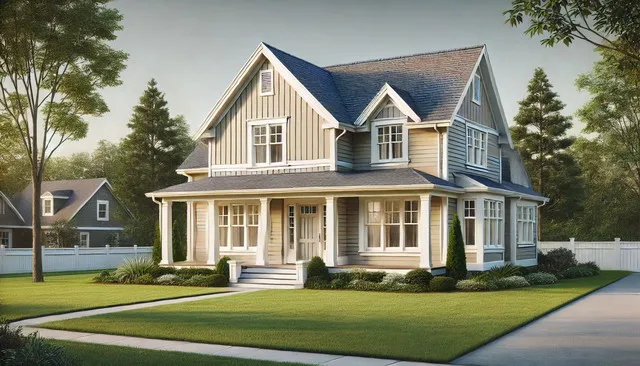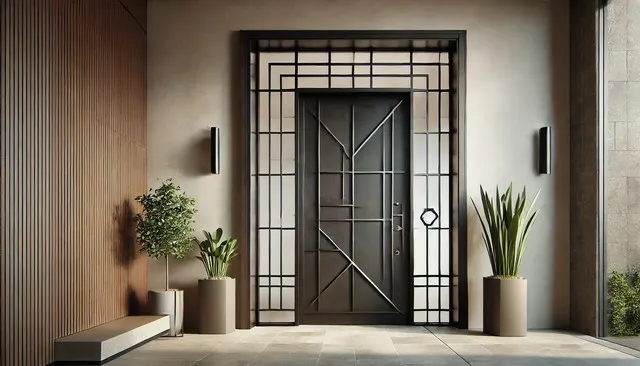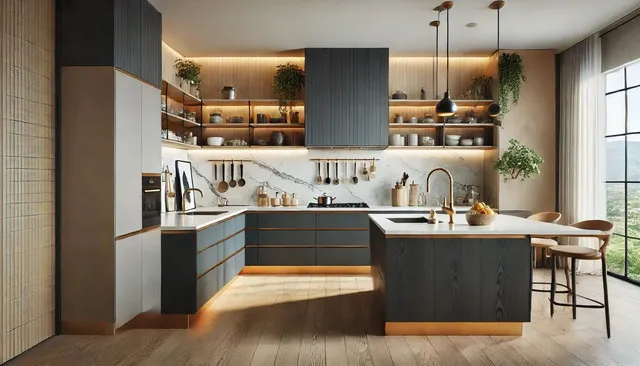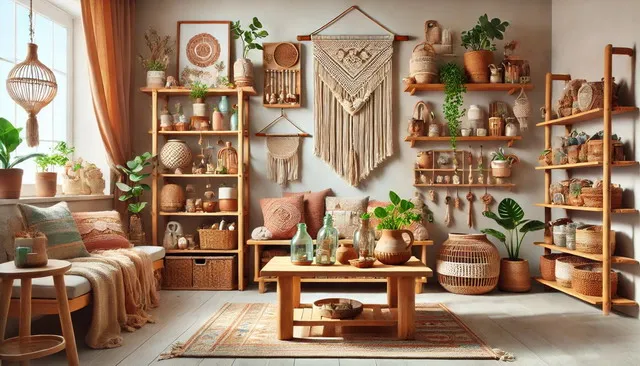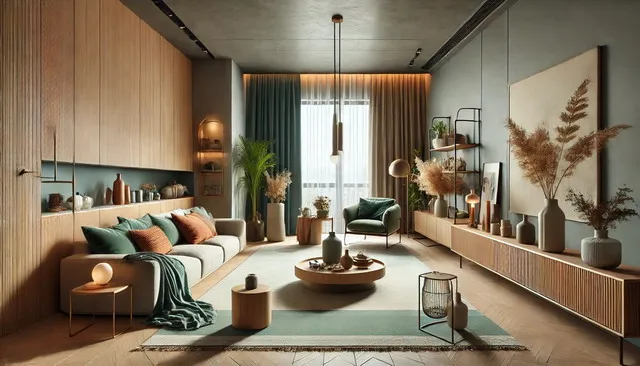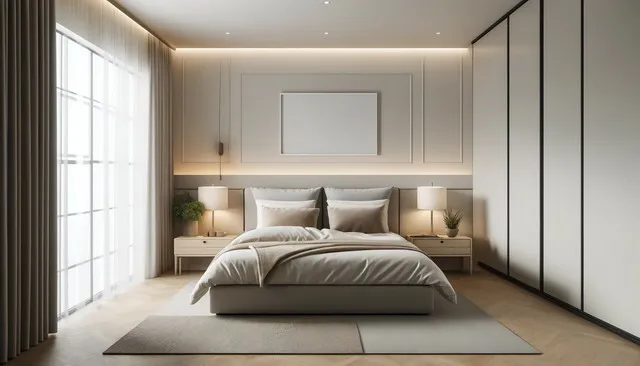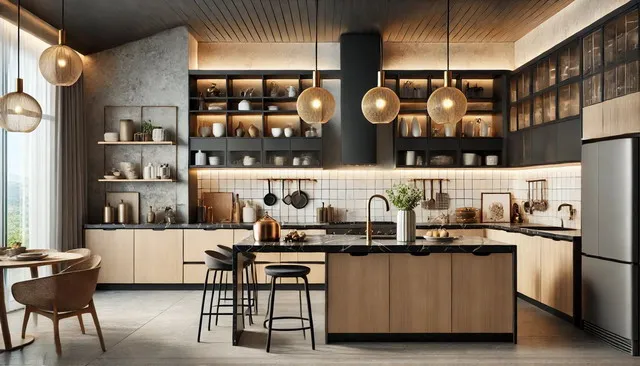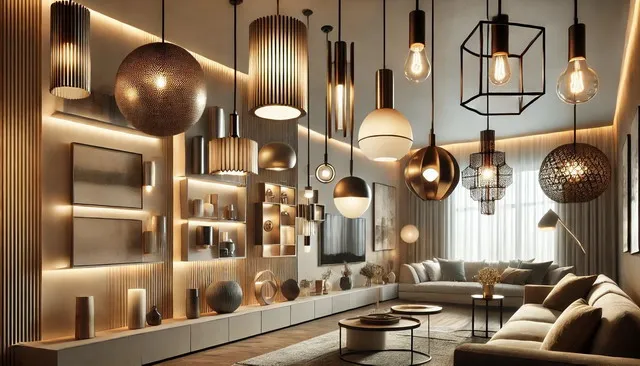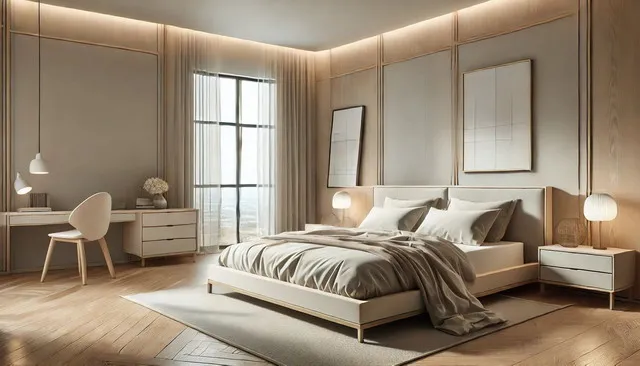As we move into 2025, home decor is undergoing a remarkable transformation. Our homes are no longer just places where we live—they have become personal sanctuaries, spaces for creativity, and reflections of our evolving values. With growing awareness of sustainability, technological advancements, and a renewed appreciation for craftsmanship, interior design in 2025 is about more than aesthetics. It’s about creating environments that promote well-being, align with eco-conscious living, and allow for authentic self-expression.
From nature-inspired color palettes to multifunctional furniture for small spaces, the trends of 2025 reflect the diverse needs and desires of modern homeowners. Whether you’re drawn to the clean lines of minimalist Scandinavian design, the bold vibrancy of maximalism, or the fusion of high-end luxury with sustainability, this year’s home decor trends offer something for everyone.
In this article, we’ll explore the key trends shaping the future of home decor in 2025, diving deep into eco-friendly materials, innovative smart home technology, and the revival of vintage and handcrafted decor. Whether you’re looking to refresh your living space or completely redesign your home, these trends will inspire you to create a space that is both beautiful and meaningful.
Sustainable Home Decor for 2025: The Future of Eco-Friendly Living
As we move into 2025, one of the most significant trends in home decor is sustainability. It’s no secret that environmental awareness has been on the rise in recent years, but in 2025, it’s more than just a trend—it’s a lifestyle. Homeowners and designers are embracing eco-friendly materials, ethical manufacturing processes, and biophilic design principles to create spaces that are not only beautiful but also responsible.
The Importance of Eco-Friendly Materials
Sustainable home decor in 2025 isn’t just about using fewer resources; it’s about making conscious choices that have a lasting positive impact on the environment. This shift toward sustainability is evident in the materials that are becoming increasingly popular. Whether it’s for furniture, flooring, or wall finishes, natural and recycled materials are leading the way.
- Recycled and Upcycled Furniture
Recycling and upcycling have transformed the way we think about furniture. Instead of discarding old pieces, designers and homeowners are finding creative ways to give new life to existing furniture. In 2025, the concept of “throwaway culture” is quickly fading. People are looking for ways to reduce waste and minimize their environmental footprint, and upcycled furniture is a perfect solution.
From turning old wooden pallets into coffee tables to using repurposed metal in bed frames, the possibilities are endless. Not only does upcycled furniture help the environment, but it also adds a unique, personalized touch to home decor. Every piece tells a story, making it much more than just a functional item.
- Biodegradable Decor Elements
As the focus on sustainability deepens, more designers are turning to biodegradable materials for decor. Items like lamps, rugs, and even wallpaper made from biodegradable resources such as hemp, bamboo, and cork are becoming common in 2025 interiors. These materials break down naturally, reducing the amount of waste that ends up in landfills.
Bamboo, in particular, has gained widespread popularity because of its rapid growth and renewability. It’s used not only for furniture but also for flooring and decorative elements. Bamboo’s versatility, durability, and eco-friendliness make it an ideal choice for those looking to embrace sustainable decor.
- Low-Impact Manufacturing Processes
Sustainability isn’t just about the materials used; it’s also about how those materials are sourced and produced. Low-impact manufacturing processes are a key focus in 2025, with many companies adopting energy-efficient methods and ethical labor practices. Brands that prioritize sustainability in production are becoming more desirable, and consumers are willing to pay a premium for products that align with their values.
Furniture companies are increasingly transparent about their production methods, offering insights into how they minimize their carbon footprint. From using non-toxic adhesives to adopting water-based finishes, the commitment to sustainability is evident across the industry.
How Sustainability Influences Design Aesthetics
One of the most fascinating aspects of the sustainability trend is how it is shaping the look and feel of home decor. In 2025, sustainable design doesn’t mean compromising on style—in fact, it’s quite the opposite. The focus on natural materials and minimal waste has led to a more organic, earthy aesthetic that feels calming and grounded.
- Embracing Imperfections
The concept of “wabi-sabi,” a Japanese philosophy that finds beauty in imperfection, has gained popularity in 2025. Sustainable decor often embraces the raw, unpolished look of natural materials, allowing their imperfections to shine through. Furniture made from reclaimed wood, for example, may have visible knots, cracks, or color variations, which only add to its charm.
This aesthetic is a refreshing contrast to the mass-produced, uniform look that has dominated the market for years. People are now drawn to one-of-a-kind pieces that showcase the inherent beauty of natural materials.
- Earthy Color Palettes
The color palettes associated with sustainable decor are inspired by nature. Shades of brown, green, beige, and terracotta dominate, creating a warm, inviting atmosphere that reflects the outdoor world. These earthy tones help to create a sense of tranquility and connection with nature, making homes feel more relaxing and harmonious.
Natural fibers such as linen, jute, and wool also play a significant role in achieving this aesthetic. Textiles made from these materials not only add texture and depth to a room but also enhance the overall sense of warmth and comfort.
Minimalist Scandinavian Home Design for 2025: Simplicity Meets Functionality
As we look ahead to 2025, minimalist Scandinavian design continues to be a dominant force in the world of interior decor. Known for its clean lines, functionality, and emphasis on simplicity, Scandinavian design has long been a favorite for those seeking a modern yet cozy aesthetic. In 2025, this design philosophy is evolving, incorporating elements of sustainability and personalization to create spaces that are both stylish and meaningful.
1. The Rise of Minimalism and Simplicity
In an increasingly complex world, more people are turning to minimalism as a way to find clarity and peace. Scandinavian design has always embraced the “less is more” philosophy, but in 2025, this approach is even more relevant. Homes are being designed with fewer but higher-quality items, focusing on functionality and comfort rather than excess.
Minimalism doesn’t mean stripping a home of personality—it’s about carefully curating spaces to ensure that each piece has a purpose. By reducing clutter and excess, Scandinavian design creates an environment that feels open, airy, and calm.
2. Characteristics of Scandinavian Design in 2025
In 2025, Scandinavian design retains its signature characteristics—neutral color palettes, natural light, and functional furniture—but with some modern updates. There’s a greater emphasis on sustainability, with many Scandinavian-inspired homes featuring eco-friendly materials like recycled wood, organic cotton, and energy-efficient lighting.
Neutral colors remain a hallmark of Scandinavian design, with shades of white, gray, and beige creating a serene backdrop. However, in 2025, there’s a growing trend toward adding pops of color, particularly muted tones like sage green, dusty blue, and blush pink. These subtle hues add warmth and personality without overwhelming the simplicity of the space.
3. Tips for Achieving a Clean and Clutter-Free Space
To create a minimalist Scandinavian-inspired home, it’s essential to focus on organization and decluttering. Storage solutions play a key role in maintaining the clean lines and open spaces that define this style. In 2025, multifunctional furniture—such as ottomans with hidden storage or beds with built-in drawers—is gaining popularity, allowing homeowners to maximize their space while keeping clutter out of sight.
Maximalist Home Decor Ideas 2025: Embracing Boldness and Personality
While minimalism continues to thrive, 2025 is also the year of its vibrant counterpart: maximalism. In stark contrast to the clean lines and neutral tones of Scandinavian-inspired homes, maximalist decor is all about making bold choices. It’s an explosion of color, texture, and personality, where more is more, and rules are made to be broken. Maximalism in 2025 isn’t just about filling a space with stuff; it’s about curating a living environment that reflects individuality and creativity.
1. Bold Colors, Patterns, and Textures
Maximalist decor is defined by its fearless use of color, pattern, and texture. In 2025, expect to see interiors drenched in jewel tones like emerald green, sapphire blue, and deep burgundy. These rich colors are layered with bold patterns—think floral wallpapers, geometric rugs, and vibrant upholstery.
Texture also plays a crucial role in maximalist design. Luxurious fabrics like velvet and silk are paired with rougher materials like exposed brick, wood, or even metal to create a sensory experience. The goal is to create visual interest in every corner of the room, whether through layering fabrics, mixing prints, or adding quirky decor items.
2. The Evolution of Maximalism
In 2025, maximalism is evolving beyond the chaotic clutter that once defined it. Today’s maximalist interiors are more thoughtful, balancing abundance with intentionality. It’s not about throwing random objects together but about curating a space that tells a story. People are choosing items that have personal meaning—whether that’s a vintage lamp, a piece of travel art, or a handmade rug.
Another exciting aspect of maximalism is its fusion with modern luxury. High-end maximalist homes are incorporating opulent materials like marble, brass, and crystal into their designs. Statement lighting, plush furniture, and oversized artwork are just a few ways maximalist spaces are achieving elegance without losing their sense of fun.
3. Statement Pieces That Define 2025 Maximalism
The heart of maximalism lies in its statement pieces. In 2025, oversized furniture, bold art installations, and unconventional decor are central to the maximalist aesthetic. A single grand chandelier, a massive abstract painting, or a vividly patterned sofa can set the tone for an entire room.
These statement pieces are designed to spark conversation and evoke emotion. Maximalist decor gives homeowners the freedom to express themselves unapologetically, blending old and new, traditional and contemporary, in a way that reflects their tastes.
Smart Home Technology Integration in 2025 Interiors: Where Innovation Meets Design
As technology continues to advance at a rapid pace, its influence on home decor and interior design is becoming more prominent. In 2025, smart home technology is seamlessly integrated into living spaces, offering convenience, efficiency, and security—all while complementing the aesthetics of modern homes. Gone are the days when tech gadgets disrupted the flow of decor; now, they enhance it, merging functionality with design in new and exciting ways.
1. The Growing Importance of Smart Home Devices
Smart home devices are no longer a luxury reserved for tech enthusiasts—they’re becoming a standard feature in homes across the globe. From smart lighting systems to automated climate control, these technologies are designed to make life easier and more efficient. In 2025, the integration of smart devices has reached a level where they’re practically invisible, yet fully functional.
Smart lighting systems that can be controlled with a voice command or a mobile app are among the most popular devices. Homeowners can easily adjust the ambiance of a room by changing the brightness or color of their lights, without interrupting the aesthetic flow of their decor.
2. How Technology is Blending with Home Decor
One of the biggest challenges in the past was how to incorporate technology into home decor without sacrificing style. In 2025, designers are finding innovative ways to make technology blend seamlessly with interiors. For example, smart mirrors with built-in LED lighting are becoming a must-have for bathrooms, while wireless charging stations are being built into furniture like side tables and desks.
Televisions are also evolving, with many homeowners opting for sleek, frameless designs that can disappear into the wall when not in use. The goal is to ensure that tech enhances the home without overpowering the overall aesthetic. This harmonious integration of technology and design is shaping the future of interior decor.
3. Smart Home Automation and Personalization
Personalization is a significant trend in 2025’s smart home technology. Homeowners want their living spaces to reflect their unique preferences, and automation allows them to do just that. Whether it’s programming the lights to dim at sunset, setting up a morning routine that automatically opens the blinds, or adjusting the thermostat based on daily schedules, smart home systems are designed to adapt to individual needs.
Voice assistants, like Amazon Alexa and Google Home, are becoming central to this automation, allowing users to control multiple aspects of their home with simple commands. The result is a home that is not only smart but also responsive to the lifestyle of its inhabitants.
Biophilic Design for Homes in 2025: Bringing Nature Indoors
Biophilic design, which focuses on integrating nature into the built environment, has been steadily gaining popularity, and in 2025, it’s a core trend in home decor. This design approach is rooted in the belief that humans have an inherent connection to the natural world, and bringing elements of nature into our homes can improve mental and physical well-being. From incorporating natural materials to maximizing natural light, biophilic design creates spaces that feel alive, calming, and in harmony with nature.
1. Incorporating Natural Elements
In 2025, biophilic design is all about blurring the lines between the indoors and outdoors. This can be as simple as introducing houseplants into every room or as complex as designing entire walls made of living plants, also known as vertical gardens. Natural materials like wood, stone, and bamboo are commonly used in furniture, flooring, and decor, giving homes a warm, organic feel.
Water features, such as indoor fountains or ponds, are also becoming more common. These elements not only add a calming, tranquil atmosphere to the home but also serve as visual focal points. The goal of biophilic design is to create a space where the beauty and serenity of nature are ever-present.
2. Maximizing Natural Light and Airflow
Natural light plays a crucial role in biophilic design. Large windows, skylights, and open layouts are key features in homes that prioritize this style. In 2025, more homeowners are opting for designs that allow sunlight to flood their living spaces, creating a bright and airy environment. In addition to its aesthetic benefits, natural light is known to boost mood and energy levels, making it an essential component of biophilic design.
Airflow is another important aspect. Homes in 2025 are being designed with better ventilation systems and layouts that allow for cross-ventilation, ensuring that fresh air circulates freely. This not only improves indoor air quality but also enhances the connection between the home and the natural world outside.
3. The Mental Health Benefits of Biophilic Design
One of the driving forces behind the rise of biophilic design in 2025 is its proven benefits for mental health. Studies have shown that being around natural elements reduces stress, boosts creativity, and enhances overall well-being. In an era where people are increasingly spending time indoors, bringing nature into the home provides a much-needed escape from the demands of daily life.
The calming influence of greenery, natural light, and organic materials creates a serene environment that promotes relaxation and mindfulness. As a result, biophilic design isn’t just a trend—it’s a lifestyle choice that prioritizes health and happiness.
2025 Color Palettes and Paint Trends: A Shift Toward Nature-Inspired Hues
Colors play an essential role in setting the mood and tone of a home, and in 2025, the color palettes and paint trends are embracing a more organic, nature-inspired approach. As people seek comfort and serenity in their homes, the dominant hues for 2025 reflect this desire for tranquility and connection with the natural world. While bold shades are still present, softer, muted tones are making a significant impact.
1. Key Colors for 2025 Interiors
The primary color trend for 2025 revolves around earthy tones that evoke feelings of warmth and relaxation. Expect to see shades of sage green, terracotta, warm beige, and muted blues dominating interior spaces. These colors are inspired by the natural world—think lush forests, open deserts, and calming seas—and are chosen for their ability to create peaceful, grounding environments.
Sage green, in particular, is one of the standout colors of 2025. Its soft, versatile hue works beautifully in living rooms, kitchens, and bedrooms, offering a soothing atmosphere that promotes relaxation. Similarly, terracotta adds warmth to any space, making it ideal for accent walls or as part of an eclectic decor scheme.
2. The Psychology Behind Popular 2025 Color Trends
The resurgence of natural tones in 2025 is deeply connected to the psychology of color and its impact on our emotions. As more people look to their homes as a place of refuge, colors that promote calm and relaxation are in high demand. Sage green, for instance, is associated with balance and harmony, making it a perfect choice for creating peaceful environments. Warm, earthy tones like terracotta and sandy beige evoke feelings of comfort and security, which is why they’re increasingly being used in communal spaces like living rooms and dining areas.
In addition to their calming qualities, these natural colors are also seen as timeless. Unlike trendier, more vibrant shades, earthy tones have a classic appeal that allows homeowners to create spaces that will look beautiful for years to come.
3. Tips for Using Trending Colors in Different Rooms
When incorporating the 2025 color trends into your home, it’s essential to consider the purpose of each room. For living rooms, where relaxation and socialization take place, softer shades of green and beige can create a welcoming atmosphere. Accent these with richer tones like terracotta in throw pillows or rugs for a touch of warmth.
In the kitchen, muted blues or soft greys can provide a calming backdrop while complementing natural materials like wood or stone countertops. For bedrooms, where serenity is key, sage green or warm neutrals create a restful environment conducive to sleep and relaxation.
If you want to incorporate bold pops of color without overwhelming a room, try using a single accent wall or smaller decor items like artwork, vases, or furniture to introduce deeper, more saturated hues.
Multifunctional Furniture for Small Spaces in 2025: Smart Solutions for Modern Living
As urbanization continues and living spaces become more compact, the demand for multifunctional furniture is at an all-time high. In 2025, the focus is not just on making furniture that looks good but on creating pieces that serve multiple purposes and maximize available space. Whether it’s for a small apartment in the city or a compact home office, multifunctional furniture is a key trend shaping interior design.
1. The Rise of Compact Living Solutions
With more people embracing smaller, more efficient homes, the need for innovative furniture solutions has grown. In 2025, compact living is no longer viewed as a limitation but as an opportunity for creativity. Designers are crafting furniture that adapts to various needs, providing flexibility without compromising on style or comfort.
Convertible furniture is one of the leading solutions for compact living. From sofa beds that transform into full-sized beds to dining tables that fold into sleek consoles, these pieces are designed to save space while offering maximum functionality. Wall-mounted desks, fold-away beds, and stackable chairs are also gaining popularity as they allow homeowners to make the most of limited square footage.
2. Smart Furniture Ideas for Small Apartments
Multifunctional furniture is particularly useful in small apartments, where space is often at a premium. In 2025, homeowners are opting for pieces that can do double duty, such as ottomans with hidden storage compartments or coffee tables that convert into desks. These smart furniture designs not only save space but also enhance the overall aesthetic of the home by eliminating clutter and creating a streamlined look.
For example, modular sofas are becoming increasingly popular in compact living spaces. These customizable pieces can be rearranged to fit any layout and often come with additional storage underneath the cushions or within the armrests. Similarly, expandable dining tables allow for flexibility when entertaining guests, while folding away neatly when not in use.
3. How Multifunctionality Enhances Aesthetics and Practicality
The beauty of multifunctional furniture lies in its ability to combine form and function seamlessly. In 2025, these pieces are designed to be as stylish as they are practical. Gone are the days when multifunctional furniture was purely utilitarian—today’s designs are sleek, modern, and available in a variety of materials and finishes to suit any interior style.
In addition to enhancing aesthetics, multifunctional furniture promotes organization and efficiency. By incorporating hidden storage and flexible design elements, these pieces help to reduce clutter and make small spaces feel larger and more open. This combination of practicality and beauty is a key reason why multifunctional furniture continues to be a top trend in 2025.
Vintage and Retro Home Decor Comeback in 2025: A Nostalgic Revival
In 2025, vintage and retro styles are making a strong comeback, driven by a desire for individuality and a yearning for nostalgia. As homeowners seek to add character and history to their spaces, they’re turning to vintage furniture, retro decor, and classic design elements to create unique interiors. This trend is not about recreating the past but about blending old and new in a way that feels fresh and modern.
1. How Vintage Styles Are Making a Resurgence
Vintage decor brings with it a sense of timelessness and authenticity that mass-produced modern furniture often lacks. In 2025, more people are choosing to incorporate vintage pieces into their homes, whether through authentic antique finds or retro-inspired designs that capture the essence of a bygone era.
Mid-century modern furniture, in particular, is seeing a resurgence. Known for its clean lines, organic shapes, and functional design, this style blends seamlessly with contemporary decor, making it a popular choice for those who want a touch of retro flair without fully committing to a vintage aesthetic.
2. Blending Retro Aesthetics with Modern Design
The key to successfully incorporating vintage or retro elements into your home in 2025 is balance. Instead of recreating an entire room from the 1960s or 1970s, homeowners are mixing retro pieces with modern designs to create a more eclectic, personalized look. For example, pairing a vintage wooden sideboard with a contemporary sofa or adding a retro lamp to a minimalist room can create a striking contrast that adds depth and interest to the space.
This blending of old and new allows for more creative freedom in interior design. Homeowners can choose the elements they love from different decades and incorporate them in a way that reflects their personality and style.
3. Key Vintage Pieces to Look for in 2025
When it comes to vintage decor in 2025, there are a few key pieces that are in high demand. Mid-century modern furniture, as mentioned, remains a favorite, with items like Eames chairs, teak sideboards, and low-slung sofas taking center stage. In addition, Art Deco-inspired pieces—think geometric patterns, bold colors, and luxurious materials like velvet and brass—are gaining popularity as a way to add a touch of glamour to modern spaces.
Other vintage-inspired trends for 2025 include retro lighting fixtures, like brass pendant lamps or Sputnik chandeliers, and nostalgic decor items like rotary phones, vintage clocks, and retro artwork. These pieces not only add character to a home but also serve as conversation starters and focal points in any room.
Sustainable Luxury in High-End Home Design 2025: Merging Eco-Consciousness with Opulence
In 2025, sustainable living is no longer just about affordability or minimalist aesthetics. High-end home design is embracing eco-consciousness in new and exciting ways, merging luxury with sustainability. This trend reflects a growing awareness among affluent homeowners who want to enjoy the finer things in life without compromising their commitment to environmental responsibility. Sustainable luxury is now defined by the use of high-quality, eco-friendly materials, artisanal craftsmanship, and energy-efficient technology.
1. The Fusion of Sustainability and Luxury
Luxury and sustainability may have seemed like opposites in the past, but in 2025, the two are becoming increasingly intertwined. High-end homes are now featuring sustainable materials like reclaimed wood, recycled metal, and eco-friendly textiles, without sacrificing elegance. Homeowners are looking for materials that are not only beautiful but also have a lower environmental impact. For instance, countertops made from recycled glass or sustainable bamboo flooring offer a sophisticated look while being environmentally responsible.
Eco-conscious homeowners are also drawn to materials that are durable and timeless. The focus is on creating spaces that are both luxurious and long-lasting, reducing the need for frequent replacements and renovations. This shift toward sustainability is seen as a way to invest in the future—not only for the environment but also in terms of long-term value for the home.
2. Eco-Friendly Yet Luxurious Materials and Finishes
Sustainable luxury is all about finding the balance between opulence and eco-consciousness. In 2025, materials like sustainably sourced marble, reclaimed wood, and organic cotton are at the forefront of this trend. These materials offer the same level of sophistication and quality as their non-sustainable counterparts, but with the added benefit of being kinder to the planet.
For example, homeowners are increasingly choosing reclaimed wood for their flooring and furniture. Not only does this add a rustic charm to their interiors, but it also reduces the demand for new timber, preserving forests and reducing deforestation. Sustainable finishes, such as water-based paints and non-toxic varnishes, are being used to maintain the luxurious appearance of high-end homes while minimizing harmful environmental impacts.
3. The Future of Bespoke, Artisanal Home Decor
Handcrafted, artisanal decor is another significant aspect of sustainable luxury in 2025. Homeowners are gravitating toward one-of-a-kind, bespoke pieces that are made by skilled artisans rather than mass-produced in factories. This focus on craftsmanship not only supports local economies but also results in unique decor items that tell a story and add character to any space.
From hand-woven rugs made from organic fibers to custom-made furniture crafted from sustainable materials, artisanal home decor allows homeowners to express their individuality while making eco-friendly choices. These pieces are often made in small batches or on a made-to-order basis, ensuring that resources are used efficiently, and waste is minimized.
Artisanal and Handcrafted Decor Trends 2025: Celebrating Craftsmanship and Local Artisans
In 2025, there is a strong desire to return to the roots of craftsmanship and handmade artistry. As consumers become more conscious of their purchases, they are turning to artisanal and handcrafted decor to fill their homes with unique, meaningful pieces. This trend is driven by a growing appreciation for the skill and time it takes to create handcrafted items, as well as a desire to support local artisans and sustainable production methods.
1. Why Craftsmanship Is Gaining Importance
Artisanal decor represents more than just a design trend—it’s a celebration of craftsmanship, tradition, and culture. In an age of mass production and fast fashion, handcrafted items stand out for their authenticity and attention to detail. People are increasingly drawn to pieces that are made with care and skill, knowing that they are investing in quality rather than quantity.
In 2025, handmade decor items are not only beautiful but also often have a story behind them. Whether it’s a hand-carved wooden table, a ceramic vase made by a local potter, or a hand-dyed textile, these pieces carry the essence of the artisans who created them. This emotional connection to decor is something that mass-produced items simply can’t replicate.
2. Popular Handcrafted Materials and Designs
Handcrafted decor in 2025 is characterized by natural materials, earthy textures, and organic shapes. Materials like clay, wood, leather, and natural fibers dominate the artisanal design landscape. Hand-thrown pottery, woven baskets, and intricately carved furniture are just a few examples of how artisans are incorporating these materials into their work.
One notable trend is the resurgence of traditional crafts, such as weaving, pottery, and woodworking. These age-old techniques are being revived by contemporary artisans who are putting a modern twist on them. For instance, hand-woven rugs with bold, geometric patterns or modern, minimalist ceramics are highly sought after for their ability to blend tradition with modern design sensibilities.
3. Supporting Local Artisans in Interior Decor
As more consumers become aware of the environmental and social impacts of their purchases, they are choosing to support local artisans and small businesses. This not only helps sustain local economies but also reduces the carbon footprint associated with importing mass-produced goods from overseas.
In 2025, it’s not uncommon to see homeowners proudly showcasing decor items that were sourced from local craftspeople. Farmers’ markets, craft fairs, and online platforms dedicated to handmade goods have become popular destinations for those seeking unique, ethically made decor. By choosing handcrafted items, homeowners are not only bringing beauty into their homes but also contributing to a more sustainable, equitable global economy.
Conclusion: Home Decor Trends in 2025—A Reflection of Personal Values and Sustainability
As we look at the home decor trends of 2025, one thing is clear: the future of interior design is deeply rooted in sustainability, personalization, and a return to craftsmanship. From embracing bold maximalist aesthetics to integrating smart home technology, the trends of 2025 reflect a growing desire for homes that are not only beautiful but also aligned with personal values and environmental responsibility.
Sustainability, in particular, plays a central role in shaping the design landscape, with eco-friendly materials, multifunctional furniture, and artisanal decor leading the charge. Whether you’re drawn to the organic warmth of biophilic design or the nostalgic charm of vintage decor, the key takeaway for 2025 is that interior design is no longer just about aesthetics—it’s about creating spaces that reflect who we are and how we want to live in harmony with the world around us.
The focus on thoughtful design choices, sustainability, and the blending of old and new ensures that homes in 2025 will be places of comfort, innovation, and timeless beauty.


